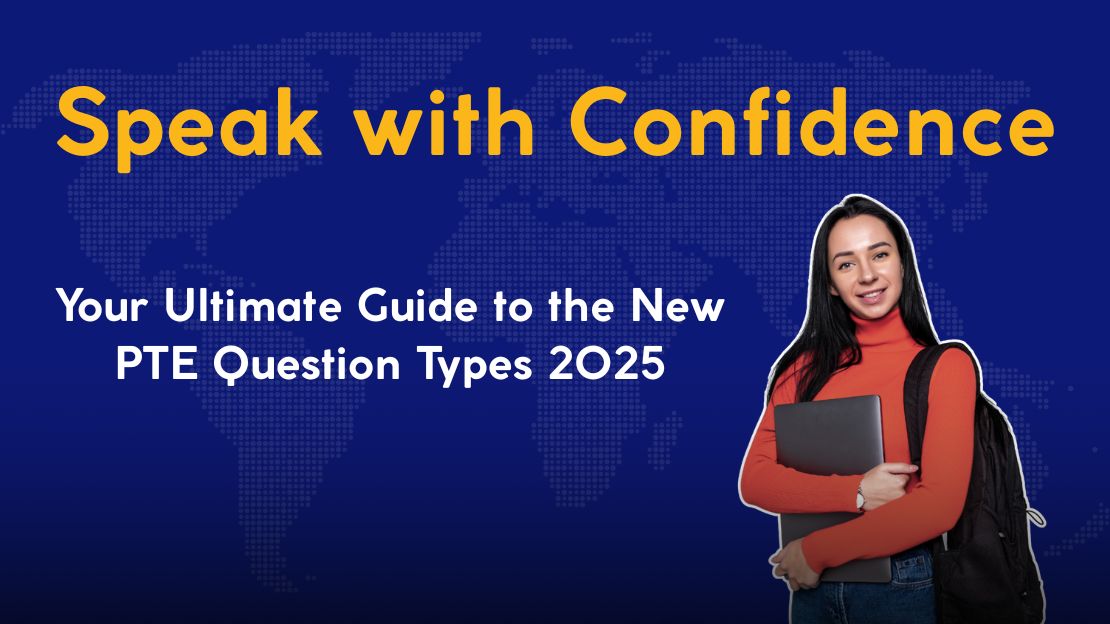Speak with Confidence: Your Ultimate Guide to the New PTE Question Types 2025

Starting on 7th August 2025, the Pearson Test of English (PTE) will introduce New PTE Question Types 2025 to its speaking section. These new tasks aren’t just about testing your grammar or vocabulary—they’re designed to evaluate your real-world communication skills. Whether you’re aiming to study abroad, apply for a job, or work in an English-speaking country, these changes will help you demonstrate how well you can engage in natural, everyday conversations. This guide breaks down the changes and provides simple, practical tips to help you prepare with confidence.
🎯 Why Pearson Is Updating the PTE Exam
Pearson has made these updates to reflect the way English is really used in academic and professional settings. Instead of focusing purely on language rules, they now want to see how well you can:
Understand and respond to conversations
Speak clearly and naturally in a variety of situations
Communicate effectively under time pressure
These updates are designed to help universities, employers, and institutions choose candidates who can interact comfortably in real-life English environments.
🔍 Introducing the New PTE Question Types
From August 2025, the Speaking section will feature two new tasks that will test your ability to engage in real conversations:
Summarize Group Discussion
Respond to a Situation
These tasks will require you to demonstrate fluency, clarity, and the ability to respond appropriately in a short amount of time. Let’s break each one down so you can get a better idea of what to expect.
🧠 Task 1: Summarize Group Discussion
What You’ll Face:
You will hear a 2–3 minute conversation between multiple speakers discussing a particular topic. After 10 seconds of preparation, you’ll need to summarize the discussion in about 2 minutes.
Your Strategy:
Listen actively and take notes on the main arguments and viewpoints.
Stay neutral—your job is to summarize the conversation, not to offer your own opinions.
Start your response with: “The discussion focused on…” and briefly summarize the key points.
Pro Tips:
Use phrases like: “One speaker pointed out…,” “Another speaker mentioned…,” or “There was disagreement on…”
Highlight the contrast between opinions, but keep it neutral and academic.
Remember, this is an objective summary, not an opportunity to give your personal opinion.
🎤 Task 2: Respond to a Situation
What You’ll Face:
You will listen to a 20–30 second audio describing a real-world scenario, such as a customer complaint or a workplace issue. After 10 seconds to prepare, you’ll have 40 seconds to respond.
Your Strategy:
Quickly identify the main issue in the scenario.
Respond with empathy and a solution—show that you understand the problem and are ready to offer help.
End confidently, saying something like: “I’ll handle that for you” or “Here’s what we can do…”
Pro Tips:
Role-play with a friend or tutor to practice common situations (e.g., customer complaints or team issues).
Focus on speaking calmly and clearly—avoid rushing through your response.
Use polite expressions such as: “I understand your concern,” “Let me assist with that,” or “I can help solve this…”
📌 Task Format Breakdown
Summarize Group Discussion
Audio: 2–3 minutes
Prep Time: 10 seconds
Speaking Time: 2 minutes
Focus: Summarizing different viewpoints and main arguments from a group discussion.
Respond to a Situation
Audio: 20–30 seconds
Prep Time: 10 seconds
Speaking Time: 40 seconds
Focus: Offering a clear, helpful, and empathetic response to a situation.
📚 How to Prepare for the New PTE Speaking Tasks
Practice Summarizing Group Discussions
Watch debates, group discussions, or podcasts. Take quick notes on the main arguments.
Practice summarizing aloud, keeping it neutral and focusing on the main ideas.
Role-Play Real-Life Scenarios
Practice with a friend or tutor by role-playing real-life situations like handling a complaint or offering a solution in a meeting.
Set a timer for 10 seconds to think and 40 seconds to respond, just like in the test.
Learn Useful Phrases for Each Task
For Summarizing Group Discussions:
“The discussion centered on…”
“One speaker argued that…”
“There was disagreement about…”
For Responding to a Situation:
“I see what you mean.”
“Let me help with that.”
“Here’s a solution…”
✅ Top Do’s for the New Format
Do keep your tone polite, professional, and confident.
Do use transition phrases to guide your speech (e.g., “Firstly,” “On the other hand,” or “To conclude”).
Do stick to the audio content—don’t add information that wasn’t mentioned.
Do manage your time—finish with a strong, clear closing statement.
❌ Common Mistakes to Avoid
Don’t use informal language or slang.
Don’t rush your responses or pause too much—maintain a steady pace.
Don’t include personal opinions in the Summarize Group Discussion—just summarize what was said.
Don’t stray off-topic—stay focused on the content in the audio.
💡 Extra Tips to Boost Your Score
Read news articles aloud to improve your fluency and pronunciation.
Record your responses and listen back to spot any areas for improvement.
Listen to real-world conversations like podcasts or interviews, and practice summarizing or responding to them.
Shadow native speakers—repeat what they say to improve your tone, rhythm, and pronunciation.
🎯 Final Thoughts
The New PTE Question Types 2025 are designed to test your ability to communicate in real-life situations, making the exam more relevant to your academic and professional goals. With the right preparation and a calm, confident approach, you can ace these new tasks and showcase your language skills.
Stay focused, practice regularly, and take advantage of the opportunity to demonstrate your real-world communication abilities!
Source: Angel EduNext
